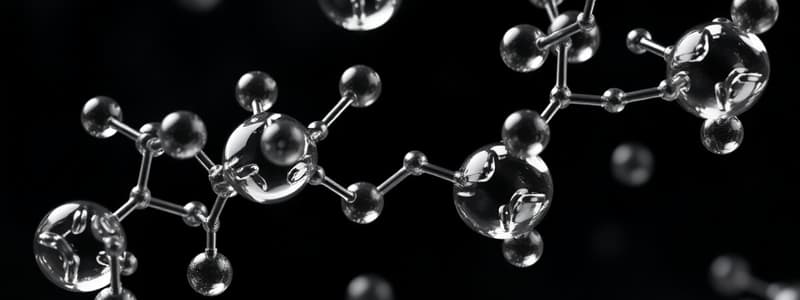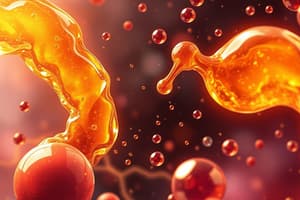Podcast
Questions and Answers
What are the two categories of essential fatty acids?
What are the two categories of essential fatty acids?
- Omega-1 and Omega-2
- Omega-3 and Omega-6 (correct)
- Omega-7 and Omega-8
- Omega-4 and Omega-5
Eicosanoids derived from omega-6 fatty acids are known to have heart-healthy effects.
Eicosanoids derived from omega-6 fatty acids are known to have heart-healthy effects.
False (B)
What is the function of docosahexaenoic acid (DHA) in the brain?
What is the function of docosahexaenoic acid (DHA) in the brain?
DHA plays important roles in synaptic transmission during fetal development.
Eicosanoids are powerful hormones that control many other hormones and important body functions, such as the central ______ system.
Eicosanoids are powerful hormones that control many other hormones and important body functions, such as the central ______ system.
Match the following fatty acids with their characteristics:
Match the following fatty acids with their characteristics:
Which of the following sources are known to provide omega-3 and omega-6 essential fatty acids?
Which of the following sources are known to provide omega-3 and omega-6 essential fatty acids?
Essential fatty acid deficiency is extremely common due to the lack of available sources in the diet.
Essential fatty acid deficiency is extremely common due to the lack of available sources in the diet.
What distinguishes phospholipids from triglycerides?
What distinguishes phospholipids from triglycerides?
What part of a phospholipid is hydrophilic?
What part of a phospholipid is hydrophilic?
Phospholipids are exclusively hydrophobic molecules.
Phospholipids are exclusively hydrophobic molecules.
What is lecithin and where can it commonly be found?
What is lecithin and where can it commonly be found?
Cholesterol is primarily found in __________ tissue, with approximately 25 percent localized there.
Cholesterol is primarily found in __________ tissue, with approximately 25 percent localized there.
Match the following substances with their functions:
Match the following substances with their functions:
What is the primary role of plant sterols?
What is the primary role of plant sterols?
The human body needs to consume cholesterol through diet.
The human body needs to consume cholesterol through diet.
What proportion of fat in the liver is made up of lecithin?
What proportion of fat in the liver is made up of lecithin?
Phospholipids can act as __________, which allows for the mixing of oil and water.
Phospholipids can act as __________, which allows for the mixing of oil and water.
What affects the appearance and freshness of certain foods?
What affects the appearance and freshness of certain foods?
Flashcards are hidden until you start studying
Study Notes
Fatty Acids
- Fatty acids are crucial for proper functioning of all bodily systems.
- The body can synthesize many fatty acids from food—known as nonessential fatty acids.
- Essential fatty acids cannot be synthesized by the body and must be obtained through diet.
- Essential fatty acids fall into two categories: omega-3 and omega-6.
- Omega-3 and omega-6 fatty acids are precursors to eicosanoids, which are powerful hormones with significant bodily functions.
- Eicosanoids derived from omega-6 fatty acids increase blood pressure, immune response, and inflammation.
- Eicosanoids derived from omega-3 fatty acids have heart-healthy effects.
- A balanced dietary intake of omega-3 and omega-6 is essential for optimal health.
- Excellent sources of omega-3 and omega-6 fatty acids include fish, flaxseed oil, hemp, walnuts, and leafy green vegetables.
Phospholipids
- Phospholipids are similar to triglycerides, but contain a phosphate group and a nitrogen-containing group instead of a third fatty-acid chain.
- This structure makes phospholipids water soluble.
- Phospholipids are amphiphilic, meaning they have both hydrophobic (water-repelling) and hydrophilic (water-attracting) properties.
- Phospholipids form the cell membrane, providing a protective barrier while allowing transport of fat and water.
- Phospholipids act as ideal emulsifiers, keeping oil and water mixed.
- Lecithin (phosphatidylcholine) is a popular food emulsifier found in egg yolk, honey, and mustard, responsible for the creamy texture of mayonnaise.
- Lecithin is present in every cell of the body, comprising 28% of brain matter and 66% of the fat in the liver.
- The body produces all the phospholipids it needs, making supplementation unnecessary.
Sterols
- Sterols differ in structure from triglycerides and phospholipids, containing multiring structures instead of fatty acids.
- Cholesterol is the most recognized sterol, playing a role in atherosclerosis.
- Cholesterol, however, also has important functions, including cell membrane structure, vitamin D synthesis, and hormone production (glucocorticoids, progesterone, testosterone, estrogens).
- Plant sterols resemble cholesterol in structure but inhibit cholesterol absorption in the human body, potentially lowering cholesterol levels.
- The body synthesizes cholesterol.
Studying That Suits You
Use AI to generate personalized quizzes and flashcards to suit your learning preferences.




